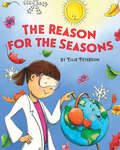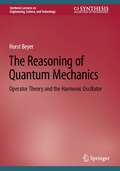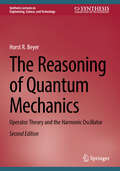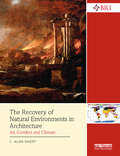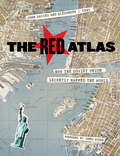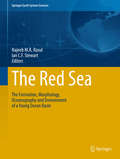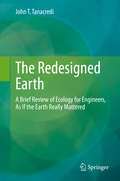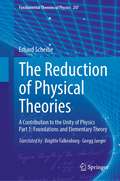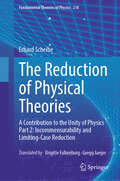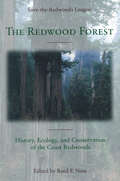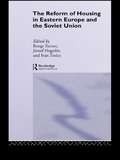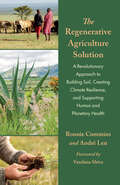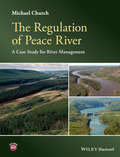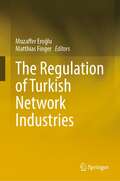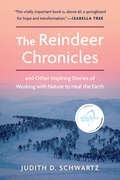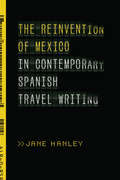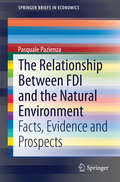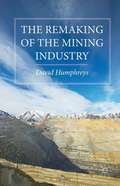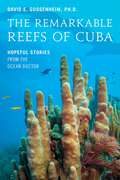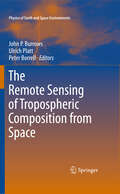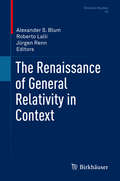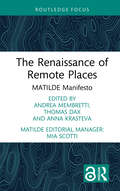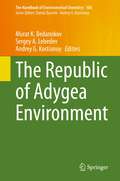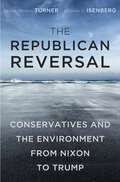- Table View
- List View
The Reason for the Seasons
by Ellie PetersonWe all know there are four seasons in a year. But HOW do we know? Join intrepid young scientist-adventurer Joulia Copernicus on a journey around the world as she explains with humor and wit how we know what causes the seasons.Winter, spring, summer, fall -- we all have a favorite season. But what makes the seasons happen in the first place? Ellie Peterson's clear, concise language and bold, kid-friendly illustrations bring science to life through narrator Joulia Copernicus, a strong and adventurous kid scientist. Kids will laugh while learning at the same time about the science behind the changing of the seasons throughout the year.
The Reasoning of Quantum Mechanics: Operator Theory and the Harmonic Oscillator (Synthesis Lectures on Engineering, Science, and Technology)
by Horst BeyerThis book presents and details the process of quantization of a classical mechanical system in a relevant physical system, the harmonic oscillator. In quantum field theory or general relativity, mathematics and physics are inextricably interwoven. As such, the book is mathematically rigorous. The author focuses on the properties of the quantum system that can be observed and measured and interprets the resulting theory. The methods of operator theory are discussed throughout in the formulation of the theory as well as in the calculation of the consequences of the theory. The book addresses the mathematical support of the probabilistic interpretation of quantum mechanics through the spectral theorems for (densely-defined and linear) self-adjoint operators in Hilbert spaces. Considerable focus is placed on the measurement process and questions the challenges of the wave function, the EPR paradox, and Bell’s inequality.
The Reasoning of Quantum Mechanics: Operator Theory and the Harmonic Oscillator (Synthesis Lectures on Engineering, Science, and Technology)
by Horst R. BeyerThis Second Edition presents and details the process of quantization of a classical mechanical system in a relevant physical system, the harmonic oscillator. As mathematics and physics are inextricably interwoven in quantum theories, the author takes a mathematically rigorous approach. The book focuses on properties of the quantum system that can be observed and measured, and the author then interprets the resulting theory. The book covers methods of operator theory in the formulation of the theory as well as in the calculation of the consequences of the theory. The author addresses the mathematical foundation of the probabilistic interpretation of quantum mechanics through the spectral theorems for (densely-defined and linear) self-adjoint operators in complex Hilbert spaces. The book also explains the measurement process and questions the challenges of the wave function, the EPR paradox, and Bell’s inequality.
The Recovery of Natural Environments in Architecture: Air, Comfort and Climate (Building Research and Information)
by C. Alan ShortThe Recovery of Natural Environments in Architecture challenges the modern practice of sealing up and mechanically cooling public scaled buildings in whichever climate and environment they are located. This book unravels the extremely complex history of understanding and perception of air, bad air, miasmas, airborne pathogens, beneficial thermal conditions, ideal climates and climate determinism. It uncovers inventive and entirely viable attempts to design large buildings, hospitals, theatres and academic buildings through the 19th and early 20th centuries, which use the configuration of the building itself and a shrewd understanding of the natural physics of airflow and fluid dynamics to make good, comfortable interior spaces. In exhuming these ideas and reinforcing them with contemporary scientific insight, the book proposes a recovery of the lost art and science of making naturally conditioned buildings.
The Red Atlas: How the Soviet Union Secretly Mapped the World
by James Risen John Davies Alexander J. KentNearly thirty years after the end of the Cold War, its legacy and the accompanying Russian-American tension continues to loom large. Russia’s access to detailed information on the United States and its allies may not seem so shocking in this day of data clouds and leaks, but long before we had satellite imagery of any neighborhood at a finger’s reach, the amount the Soviet government knew about your family’s city, street, and even your home would astonish you. Revealing how this was possible, The Red Atlas is the never-before-told story of the most comprehensive mapping endeavor in history and the surprising maps that resulted. From 1950 to 1990, the Soviet Army conducted a global topographic mapping program, creating large-scale maps for much of the world that included a diversity of detail that would have supported a full range of military planning. For big cities like New York, DC, and London to towns like Pontiac, MI and Galveston, TX, the Soviets gathered enough information to create street-level maps. What they chose to include on these maps can seem obvious like locations of factories and ports, or more surprising, such as building heights, road widths, and bridge capacities. Some of the detail suggests early satellite technology, while other specifics, like detailed depictions of depths and channels around rivers and harbors, could only have been gained by actual Soviet feet on the ground. The Red Atlas includes over 350 extracts from these incredible Cold War maps, exploring their provenance and cartographic techniques as well as what they can tell us about their makers and the Soviet initiatives that were going on all around us. A fantastic historical document of an era that sometimes seems less distant, The Red Atlas offers an uncanny view of the world through the eyes of Soviet strategists and spies.
The Red Sea
by Najeeb M.A. Rasul Ian C.F. StewartThis book presents a broad overview of the current state of knowledge regarding the Red Sea, from its geological formation and oceanographic development to the environmental influences on its ecology and the changes it is experiencing due to the rapid development of its coastlines and role as one of the world's major transport routes. The book gathers invited contributions from researchers with an interest in the geology, geophysics, oceanography and environment of the Red Sea, while also providing comprehensive new data and a complete review of the literature. It will be of interest not only to researchers actively studying the sea and its surroundings, but will also appeal to all those involved in planning and managing the Red Sea, its environment, its resources and the countries which rely on its existence.
The Redesigned Earth: A Brief Review of Ecology for Engineers, As If the Earth Really Mattered
by John T. TanacrediThis book provides insight into the basic aspects of ecology that impact or are affected by engineering practices. Ecological principals are described and discussed through the lens of the influences that built structures have on the Earth’s biological, geological, and chemical systems. The text goes on to elucidate the engineering influences that have or will influence the face of the Earth. These influences redesign the Earth, either by destroying natural systems and replacing them with highly subsidized systems or by attempting to restore highly disturbed or contaminated systems with the basic natural systems that were originally present.
The Reduction of Physical Theories: A Contribution to the Unity of Physics Part 1: Foundations and Elementary Theory (Fundamental Theories of Physics #207)
by Erhard ScheibeUsing simple physical examples, this work by Erhard Scheibe presents an important and powerful approach to the reduction of physical theories. Novel to the approach is that it is not based, as usual, on a single reduction concept that is fixed once and for all, but on a series of recursively constructed reductions, with which all reductions appear as combinations of very specific elementary reductions. This leaves the general notion of theory reduction initially open and is beneficial for the treatment of the difficult cases of reduction from the fields of special and general relativity, thermodynamics, statistical mechanics,and quantum mechanics, which are treated in the second volume. The book is systematically organized and intended for readers interested in philosophy of science as well as physicists without deep philosophical knowledge.
The Reduction of Physical Theories: A Contribution to the Unity of Physics Part 2: Incommensurability and Limiting-Case Reduction (Fundamental Theories of Physics #218)
by Erhard ScheibeBy describing examples of four fundamental physical theories, this work of Erhard Scheibe presents an important and powerful approach to reduction in physics. Novel to the approach is that it is based not on a single eternally valid concept of reduction, but on a series of recursively constructed reductions, with which all reductions appear as combinations of very specific elementary reductions. In addition to the kinds of reduction introduced in the first volume, the limiting case reduction is included as a new reduction type here, which becomes effective in combination with those introduced earlier. This second volume demonstrates the far-reaching consequences of the concept for selected examples in physics: Special and General Relativity Theory, and Quantum Mechanics. A separate chapter is dedicated to the subtle concept of micro-reduction and to kinetic theory. The book is systematically organized and intended for readers interested in philosophy of science as well as physicists without deep philosophical knowledge.
The Redwood Forest: History, Ecology, and Conservation of the Coast Redwoods
by Reed F. Noss Save-the-Redwoods LeagueEvidence is mounting that redwood forests, like many other ecosystems, cannot survive as small, isolated fragments in human-altered landscapes. Such fragments lose their diversity over time and, in the case of redwoods, may even lose the ability to grow new, giant trees.The Redwood Forest, written in support of Save-the-Redwood League's master plan, provides scientific guidance for saving the redwood forest by bringing together in a single volume the latest insights from conservation biology along with new information from data-gathering techniques such as GIS and remote sensing. It presents the most current findings on the geologic and cultural history, natural history, ecology, management, and conservation of the flora and fauna of the redwood ecosystem. Leading experts offer a comprehensive account of the redwoods ecosystem, with specific chapters examining the history of the redwood lineage; terrestrial flora and fauna, communities, and ecosystems; aquatic ecosystems; landscape-scale conservation planning; and management alternatives relating to forestry, restoration, and recreation; among other topics.The Redwood Forest offers a case study for ecosystem-level conservation and gives conservation organizations the information, technical tools, and broad perspective they need to evaluate redwood sites and landscapes for conservation. It contains the latest information from groundbreaking research on such topics as redwood canopy communities, the role of fog in sustaining redwood forests, and the function of redwood burls. It also presents sobering lessons from current research on the effects of forestry activities on the sensitive faunas of redwood forests and streams. The key to perpetuating the redwood forest is understanding how it functions; this book represents an important step in establishing such an understanding.
The Reform of Housing in Eastern Europe and the Soviet Union
by József Hegedüs Bengt Turner Iván TosicsFirst published in 1992. Routledge is an imprint of Taylor & Francis, an informa company.
The Regenerative Agriculture Solution: A Revolutionary Approach to Building Soil, Creating Climate Resilience, and Supporting Human and Planetary Health
by Ronnie Cummins Andre Leu&“Read this book to understand why you should care about regenerative agriculture. Until the public is better-informed and insists on sweeping changes to current agricultural policy . . . we will continue to degrade our planet and destabilize our climate. Leu and Cummins, through inspiring stories and solid science, show just how quickly we could turn that around.&”—Allan Savory, president, Savory Institute; chairman, Africa Centre for Holistic ManagementIs it possible that the solution to the global climate emergency lies in a &“waste&” agricultural product? The best-kept secret in today&’s world is that solutions to some of our most pressing issues—food insecurity, deforestation, overgrazing, water scarcity, rural poverty, forced migration—lie in adopting, improving, and scaling up organic and regenerative agriculture best practices.The Regenerative Agriculture Solution starts with the story of how two brothers—Jose and Gilberto Flores—are at the leading edge of this approach, pioneering the use of the previously discarded leaves of the prodigious agave plant to regenerate agricultural soils, reduce erosion, and improve water capture.When Ronnie Cummins, the cofounder of Organic Consumer Association (OCA) and Regeneration International, met the Flores brothers in 2019 and witnessed their revolutionary agave agroforestry system, he knew they were onto something important.Cummins had spent decades studying the potential and pitfalls of organic and regenerative agriculture and knew best practices when he saw them. He started to write a book about Flores&’s brother and other visionary people, such as Dr Vandana Shiva, Allan Savory, and John Liu, who started landscape-scale regeneration projects. The scientific data was even more convincing, suggesting that these projects—and others like it—could revolutionize how we understand the climate catastrophe.Sadly, Cummins passed away in April 2023, in the midst of working on the book. Not to leave this work unfinished, Ronnie&’s widow and OCA cofounder, Rose, called on their friend, colleague, and collaborator, Regeneration International&’s cofounder André Leu, to complete the work and place the Flores brothers&’ breakthroughs in the broader context of regenerative agriculture solutions to the world&’s many interlocking ecological crises.The result isThe Regenerative Agriculture Solution, a book that shows how regenerating our forests, rangelands, and farming ecosystems can cool our planet, restore the climate, and enrich our communities.
The Regulation of Peace River: A Case Study for River Management
by Michael ChurchThis book presents a comprehensive overview of the first longitudinal study of the downstream response of a major river to the establishment of a large hydropower facility and dams. Peace River, a northward flowing boreal river in northwestern Canada was dammed in 1967 and the book describes the morphological response of the 1200 km downstream channel and the response of riparian vegetation to the change in flow regime over the first forty years of regulated flows. Beginning with a description of the effect of regulation on the flow and sediment regimes of the river, the book proceeds to study changes in downstream channel geometry on the main stem, on the lowermost course of tributaries, and on the hydraulic geometry, the overall morphology of the channel, and riparian vegetation succession. The river is subject to annual freeze-up and break-up, so a chapter is devoted to the ice regime of the river. A chapter compares the effects of two extraordinary post-regulation flood events. The penultimate chapter presents a prediction of the ultimate equilibrium form of the regulated river based on rational regime theory. An online database of all the main observations will provide invaluable material for advanced students of river hydraulics and geomorphology. This book carefully brings together a range of studies that have been previously inaccessible providing a rare and comprehensive analysis of the effects of a big dam on a river, a river that itself represents an example of the kind of system that is likely to receive considerable attention in the future from dam engineers and environmentalists. • An invaluable reference to river scientists, hydroelectric power developers, engineers and environmentalists • Focus on a northward flowing boreal river, a type that holds most of the remaining hydroelectric power potential in the Northern Hemisphere • Exceptional separation of water and sediment sources, permitting study of the isolated effect of manipulating one of the two major governing conditions of river processes and form • Unique example of water regulation and both natural and engineered flood flows • Detailed study of both morphological changes of the channel and of the riparian vegetation • Online data supplement including major data tables and numerous maps. Details of the main observations and provides material for problem study by advanced students of river hydraulics and geomorphology are provided
The Regulation of Turkish Network Industries
by Matthias Finger Muzaffer EroğluThis book brings together academics and experts on Turkish network industries. It provides fundamental information on the current developments regarding regulation of the different network industries in Turkey. Turkey has gone through a liberalization process in most of the network industries during the past 20 years. In most of them, independent regulatory authorities have been established, but some network industries are still remaining under the central or local government regulatory regime. As a result, there is now a very complicated regulatory regime in place which makes Turkey’s regulatory system difficult to understand for practitioners, academics, lawyers, researchers and investors. This book offers unique insight into Turkey’s regulatory regime in various network industries. It also offers a historical background to regulation, a description of the current regulatory regimes, as well as an analysis of the foreseeable evolutions. The book covers all the important network industries in Turkey. No similar book is available on the market to date. Moreover, the book provides an extensive analysis of the current regulatory regimes in the energy, the transport, and the telecommunications industries. This book should be of interest to anyone wishing to understand Turkish regulation and will be very helpful handbook to researchers who are interested in regulation of network industries not only in Turkey but also in other developing countries, as Turkey is quite representative of other emerging countries. Readers will acquire a thorough understanding of the state of play of the Turkish network industries and their regulation.
The Reindeer Chronicles: And Other Inspiring Stories of Working with Nature to Heal the Earth
by Judith D. Schwartz&“Compelling, Fascinating, sometimes unexpectedly moving, this vitally important book is, above all, a springboard for hope and transformation.&”—Isabella Tree&“A lucid and compelling look at the global movement of ecological rehabilitation.&”— The Boston GlobeIn a time of uncertainty about our environmental future—an eye-opening global tour of some of the most wounded places on earth, and stories of how a passionate group of eco-restorers is leading the way to their revitalization.Award-winning science journalist Judith D. Schwartz takes us first to China&’s Loess Plateau, where a landmark project has successfully restored a blighted region the size of Belgium, lifting millions of people out of poverty. She journeys on to Norway, where a young indigenous reindeer herder challenges the most powerful orthodoxies of conservation—and his own government. And in the Middle East, she follows the visionary work of an ambitious young American as he attempts to re-engineer the desert ecosystem, using plants as his most sophisticated technology.Schwartz explores regenerative solutions across a range of landscapes: deserts, grasslands, tropics, tundra, Mediterranean. She also highlights various human landscapes, the legacy of colonialism and industrial agriculture, and the endurance of indigenous knowledge.The Reindeer Chronicles demonstrates how solutions to seemingly intractable problems can come from the unlikeliest of places, and how the restoration of local water, carbon, nutrient, and energy cycles can play a dramatic role in stabilizing the global climate. Ultimately, it reveals how much is in our hands if we can find a way to work together and follow nature&’s lead.&“Judith Schwartz proves, once again, that she is one of ecology&’s most indispensable writers. . . The Reindeer Chronicles is at once visionary and pragmatic—clear-eyed about the immense planetary challenges we face, yet unfailingly hopeful about our ability to forge a new relationship with nature. This book shows us what Aldo Leopold&’s land ethic looks like in the twenty-first century.&”—Ben Goldfarb, PEN America Literary Award-winning author of Eager
The Reinvention of Mexico in Contemporary Spanish Travel Writing
by Jane HanleyThe long history of transatlantic movement in the Spanish-speaking world has had a significant impact on present-day concepts of Mexico and the implications of representing Mexico and Latin America more generally in Spain, Europe, and throughout the world. In addition to analyzing texts that have received little to no critical attention, this book examines the connections between contemporary travel, including the local dynamics of encounters and the global circulation of information, and the significant influence of the history of exchange between Spain and Mexico in the construction of existing ideas of place. To frame the analysis of contemporary travel writing, author Jane Hanley examines key moments in the history of Mexican-Spanish relations, including the origins of narratives regarding Spaniards' sense of Mexico's similarity to and difference from Spain. This history underpins the discussion of the role of Spanish travelers in their encounters with Mexican peoples and places and their reflection on their own role as communicators of cultural meaning and participants in the tourist economy with its impact—both negative and positive—on places.
The Relationship Between FDI and the Natural Environment
by Pasquale PazienzaThis work examines in depth the relationship between foreign direct investment and the environment. Over the last few decades, increasing levels of environmental degradation have been recorded and have been claimed to be particularly attributable to globalization and the widespread increase of economic activities, in particular foreign direct investments (FDIs). However, the environmental implications of FDIs are not easily identified and contradictory views and arguments have been presented. This work contributes to the debate by closely analyzing the specific literature produced over the last three decades, and by presenting and discussing recent trends and prospects with regard to the FDI phenomenon.
The Remaking of the Mining Industry
by David HumphreysThe emergence of China as a major economic power in the first decade of the millennium prompted the biggest commodity boom of modern times. Soaring prices gave rise to talk of a commodity 'super cycle' and induced a wave of resource nationalism in mineral-rich countries. It also stirred up concerns of supply shortages in mineral-consuming countries. The author, who served as chief economist at two of the world's largest mining companies during these years, describes how and why this resulted in a transformation – a 'remaking' – of the mining industry. The book tells of how the markets in which the industry operated changed, how the industry was restructured through acquisition and investment, and how a cast of new players from emerging economies arrived on the scene. With the boom now passed, the book concludes with some reflections on what the changes imply for the future of the industry and the environmental and political challenges it will face
The Remarkable Reefs Of Cuba: Hopeful Stories From the Ocean Doctor
by David E. GuggenheimSince 1970, the Caribbean has lost half of its coral reefs, an ominous and accelerating phenomenon that extends around the world. Beyond the unfathomable heartbreak of the loss of such exquisite beauty from the earth, coral&’s loss represents the annual loss of billions of dollars from the global economy and the end of a way of life for billions that depend on these ecosystems. Marine scientist and conservation leader Dr. David E. Guggenheim has had a front-row seat to this disaster. But when he began a new chapter of his career in Cuba, he found something completely unexpected: hope. After years and years of watching reefs deteriorate, Guggenheim was astonished to come face-to-face with Cuba's remarkably healthy coral reefs overflowing with fish and other marine life. The Remarkable Reefs of Cuba reveals the hidden potential that Cuba&’s reefs may contain for the reefs of the world.While the past 60 years have seen the worst decline in ocean health in human history, Cuba&’s oceans and coral reefs remain remarkably healthy, a living laboratory never-before-seen by this generation of scientists. Which begs the question: why are Cuba&’s ocean waters so healthy? The answer is deeply intertwined with the country&’s extraordinary and singularly unique history, from its dramatic political past to its world-class environmental protections influenced by an unlikely partner, Captain Jacques-Yves Cousteau. This buoyant book tells the story of the demise of the world&’s ocean ecosystems, the hard work of those desperately trying to save it, and an unexpected beacon of hope from an island full of mystery and surprises.
The Remote Sensing of Tropospheric Composition from Space
by John P. Burrows Peter Borrell Ulrich PlattThe impact of anthropogenic activities on our atmospheric environment is of growing public concern and satellite-based techniques now provide an essential component of observational strategies on regional and global scales. The purpose of this book is to summarise the state of the art in the field in general, while describing both key techniques and findings in particular. It opens with an historical perspective of the field together with the basic principles of remote sensing from space. Three chapters follow on the techniques and on the solutions to the problems associated with the various spectral regions in which observations are made. The particular challenges posed by aerosols and clouds are covered in the next two chapters. Of special importance is the accuracy and reliability of remote sensing data and these issues are covered in a chapter on validation. The final section of the book is concerned with the exploitation of data, with chapters on observational aspects, which includes both individual and synergistic studies, and on the comparison of global and regional observations with chemical transport and climate models and the added value that the interaction brings to both. The book concludes with scientific needs and likely future developments in the field, and the necessary actions to be taken if we are to have the global observation system that the Earth needs in its present, deteriorating state. The appendices provide a comprehensive list of satellite instruments, global representations of some ancillary data such as fire counts and light pollution, a list of abbreviations and acronyms, and a set of colourful timelines indicating the satellite coverage of tropospheric composition in the foreseeable future. Altogether, this book will be a timely reference and overview for anyone working at the interface of environmental, atmospheric and space sciences.
The Renaissance of General Relativity in Context (Einstein Studies #16)
by Jürgen Renn Roberto Lalli Alexander S. BlumThis contributed volume explores the renaissance of general relativity after World War II, when it transformed from a marginal theory into a cornerstone of modern physics. Chapters explore key historical processes related to the theory of general relativity, in addition to presenting a thorough treatment of the relevant science behind these episodes. A broad historiographical framework is introduced first, thus providing the broad context in which the given computational approaches and case studies occurred. Written by an international and interdisciplinary group of expert authors, these chapters will bring readers to a more complete understanding of Einstein’s theory. Specific topics include:Social and citation networksThe Fock-Infeld disputeWheeler’s turn to gravitation theoryThe position of general relativity in theories of fundamental interactionsThe pursuit of a quantum theory of gravityThe emergence of dark matter in relation to cosmological modelsInstitutional frameworks for gravitational wave search in EuropeThe Renaissance of General Relativity in Context is ideal for historians, philosophers, and sociologists of science. Students and researchers in physics will also be interested in the topics explored.
The Renaissance of Remote Places: MATILDE Manifesto (Routledge Studies on Remote Places and Remoteness)
by Anna Krasteva Andrea Membretti Thomas DaxWith a particular attention to remote places and marginalised territories, this book provides a conceptualisation of the role of internal and international migration to the local development and resilience of the rural and mountain regions of Europe. The book is a collective effort produced by the international and multi-disciplinary network of the Horizon 2020 project MATILDE. In declaring a public and trans-regional position – in the form of a Manifesto for the renaissance of remote places - the book contributes to a new narrative about migration and rural/mountain territories for the future of the entire continent. Mobilizing new data and scientific-based information, the book calls for putting remote regions and their inhabitants at the core of innovative policies at local, regional, national and EU levels. An important resource for researchers, students and policymakers in human and population geography, rural studies, migration studies, social and political sciences.
The Renormalization Group and Condensed Matter Physics
by David R. Nelson Grace H. ZhangA graduate-level entrée to the application of renormalization group theory to condensed matter physicsRenormalization group ideas have had a major impact on condensed matter physics for more than a half century. This book develops the theory and illustrates the broad applicability of the renormalization group to major problems in condensed matter physics. Based on course materials developed and class-tested by the authors at Harvard University, the book will be especially useful for students, as well as researchers in condensed matter physics, soft matter physics, biophysics, and statistical physics. After reviewing Ising models, lattice gases, and critical point phenomena, the book covers quantum critical phenomena; the statistical mechanics of linear polymer chains; fluctuating sheet polymers; the dynamics associated with the Navier-Stokes equations and simplified models of randomly stirred fluids; the properties of &“active matter&”; and more.Explores the broad applicability of renormalization groups to condensed matterCovers critical phenomena in different dimensions, quantum critical points, polymer physics and flexural phonons in free-standing graphene, nonequilibrium fluid dynamics, and moreProvides a modern, physics-centered entrée, suitable for both course use and self-studyFeatures material ideal for graduate-level students as well as researchersIncludes exercises throughoutOffers a solutions manual for exercises (available only to instructors)
The Republic of Adygea Environment (The Handbook of Environmental Chemistry #106)
by Andrey G. Kostianoy Murat K. Bedanokov Sergey A. LebedevThis book outlines the current status of the environment in the Republic of Adygea in Russia. The book assesses the environmental conditions, ecological state, climate and vegetation change, anthropogenic loads to soil, water and atmosphere as well as highlighting the potential of water resources, renewable energy and development of tourism, agriculture and industry in this region. It also presents the mechanisms of legal, ecological and economic regulation and environmental insurance in the Republic of Adygea. This book introduces the Republic of Adygea to readers who are not familiar with the Republic and its beautiful landscapes, history and people. It offers a valuable source of information for a broad readership, from students and scientists interested in environmental sciences, to policymakers and practitioners working in the fields of environmental policy and management.
The Republican Reversal: Conservatives and the Environment from Nixon to Trump
by James Morton TurnerNot long ago Republicans took pride in their tradition of environmental leadership. The GOP helped create the EPA, extend the Clean Air Act, and protect endangered species. Today Republicans denounce climate change as a “hoax” and seek to dismantle environmental regulations. What happened? James Morton Turner and Andrew C. Isenberg provide answers.
